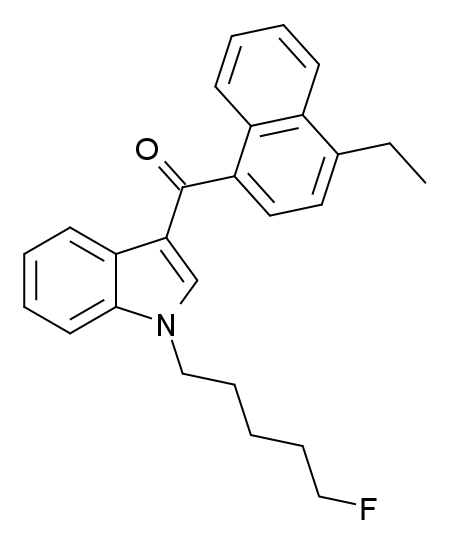Summary
EAM-2201, also known as 4′-ethyl-AM-2201, 5″-fluoro-JWH-210, or SGT-14, is a substance believed to function as a potent agonist for cannabinoid receptors. This compound was not documented in scientific or patent literature until Japanese laboratories initially detected it in July 2012 as an ingredient in synthetic cannabis smoking mixtures. Much like its closely related counterpart, MAM-2201, which had emerged approximately a year earlier, EAM-2201 seems to represent another innovative creation by designer drug producers, primarily intended for recreational purposes.
In terms of its structure, EAM-2201 is a hybrid compound derived from two established cannabinoids, JWH-210 and AM-2201, both of which had previously been utilized as active components in synthetic cannabis blends before their prohibition in numerous countries.
| Identifiers | |
|---|---|
| IUPAC name | |
| CAS Number | 1364933-60-7 |
|---|---|
| PubChem CID | 71308187 |
| ChemSpider | 29341514 |
| UNII | OO52S1U9ET |
| CompTox Dashboard (EPA) | DTXSID50745434 |
| Chemical and physical data | |
| Formula | C26H26FNO |
| Molar mass | 387.498 g·mol−1 |

Pharmacology
EAM-2201 is identified as a potent full agonist, exhibiting a binding affinity of 0.380 nM at CB1 receptors and 0.371 nM at CB2 receptors.
Legal Status
- In the United States, all CB1 receptor agonists from the 3-(1-naphthyl)indole class, including EAM-2201, are classified as Schedule I Controlled Substances.
- In New Zealand, EAM-2201 was temporarily categorized as a controlled drug from December 6, 2012, due to reports of addiction and psychosis associated with products containing EAM-2201. Some users have protested this ban, claiming medical benefits, especially for conditions like phantom limb pain.
- Germany classifies EAM-2201 as an Anlage II controlled drug.
- Since October 2015, EAM-2201 has been designated as a controlled substance in China.
FAQ
- What is EAM-2201?
- EAM-2201 is a synthetic compound known for its potential as a full agonist for cannabinoid receptors. It has been associated with recreational use.
- How does EAM-2201 work?
- EAM-2201 interacts with cannabinoid receptors, particularly CB1 and CB2, and is believed to induce various effects similar to those of cannabis.
- What is the binding affinity of EAM-2201 at cannabinoid receptors?
- EAM-2201 has a binding affinity of 0.380 nM at CB1 and 0.371 nM at CB2 receptors, indicating strong interaction with these receptors.
- Is EAM-2201 legal in the United States?
- No, EAM-2201, like other CB1 receptor agonists of the 3-(1-naphthyl)indole class, is classified as a Schedule I Controlled Substance in the United States, making it illegal.
- Why was EAM-2201 banned in New Zealand?
- EAM-2201 was temporarily banned in New Zealand due to reports of addiction and psychosis associated with its use in products. Some users, however, have protested this ban, claiming medical benefits for conditions like phantom limb pain.
- What is the legal status of EAM-2201 in Germany?
- EAM-2201 is classified as an Anlage II controlled drug in Germany, indicating that it is subject to strict regulation.
- Is EAM-2201 a controlled substance in China?
- Yes, as of October 2015, EAM-2201 is considered a controlled substance in China.
- Are there potential medical uses for EAM-2201?
- While some individuals have claimed medical benefits from EAM-2201, its use for medicinal purposes is generally not supported, and it is more commonly associated with recreational use.
- Is EAM-2201 safe to use?
- The safety of EAM-2201 is a matter of concern, and its unregulated nature can lead to unpredictable health risks. It is not approved for medical or recreational use.
References
- Anvisa (July 24, 2023): Anvisa, the Brazilian Health Regulatory Agency, published Collegiate Board Resolution No. 804 on July 24, 2023. This resolution pertains to lists of narcotic, psychotropic, precursor, and other substances under special control. It was officially documented in the Diário Oficial da União on July 25, 2023, and is available for reference until August 27, 2023.
- Kim JH, Kim HS, Kong TY, Lee JY, Kim JY, In MK, Lee HS (February 2016): This research delves into the in vitro metabolism of EAM-2201, a novel synthetic cannabinoid, within human liver microsomes and human recombinant cytochrome P450s. The findings were published in the Journal of Pharmaceutical and Biomedical Analysis in February 2016.
- Uchiyama N, Kawamura M, Kikura-Hanajiri R, Goda Y (April 2013): In April 2013, a study identified URB-754 as a new class of designer drug and detected 12 synthetic cannabinoids in illegal products. The research was published in Forensic Science International.
- Hess C, Schoeder CT, Pillaiyar T, Madea B, Müller CE (July 1, 2016): A pharmacological evaluation of synthetic cannabinoids, recognized as constituents of spice, was conducted. This evaluation was documented in Forensic Toxicology in July 2016.
- 21 U.S.C. § 812: The United States Code (21 U.S.C.) in Section 812 outlines the Schedules of controlled substances in the United States, providing the legal framework for regulating various substances.
- McNeilly H (October 1, 2012): A news report from the New Zealand Herald in October 2012 highlights a personal account of a former legal high user who believed to have been “possessed by a demon.”
- “Amputee: K2 ‘takes away my pain'”: This story from the Bay of Plenty Times, published by the New Zealand Herald on November 28, 2012, explores how synthetic cannabinoids like K2 were used by an amputee to alleviate pain in the absence of medicinal marijuana, which was unavailable in New Zealand.
- “关于印发《非药用类麻醉药品和精神药品列管办法》的通知 (in Chinese)”: This Chinese notification from the China Food and Drug Administration on September 27, 2015, discusses the regulation of non-medicinal narcotic drugs and psychotropic drugs.
- “EAM-2201”: Cayman Chemical provides information on EAM-2201, a synthetic compound with potential cannabinoid receptor activity, as of July 21, 2015.